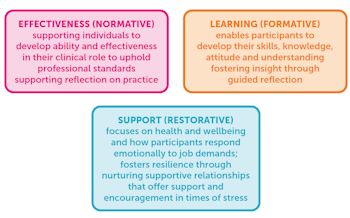Reflective Supervision should:
- enable registrants to reflect on personal, professional and practice (service provision) topics to support improved safety, quality and person-centred practice (Figure 1)
- not be confused with performance management or with the client focused elements of safeguarding supervision
- outline a clear distinction between appraisal as an employee, revalidation as a registrant and reflective supervision as a professional
- ensure that the reflective supervision session is attributed as a professional reflective discussion that can be counted as part of revalidation processes
- have protected time set aside and be confidential to the participants unless a concern is raised that requires escalation
- be defined within a context of lifelong learning and professional development (Figure 3)

-
Elements of Reflective Supervision
Elements of Reflective Supervision:
Supervisors and Supervisees take part in Reflective Supervision understanding the elements of Reflective Supervision and understanding their role and responsibilities in maximising the effectiveness of the experience.
Registrants may choose an appropriate element based on the focus of the supervision session.The following elements of Reflective Supervision align with Proctor’s Supervision Model (Proctor 2010) and emphasise how each element has a separate purpose and can be used separately or interchangeably depending on the purpose of the Reflective Supervision session.
Click here to view examples in practice:




